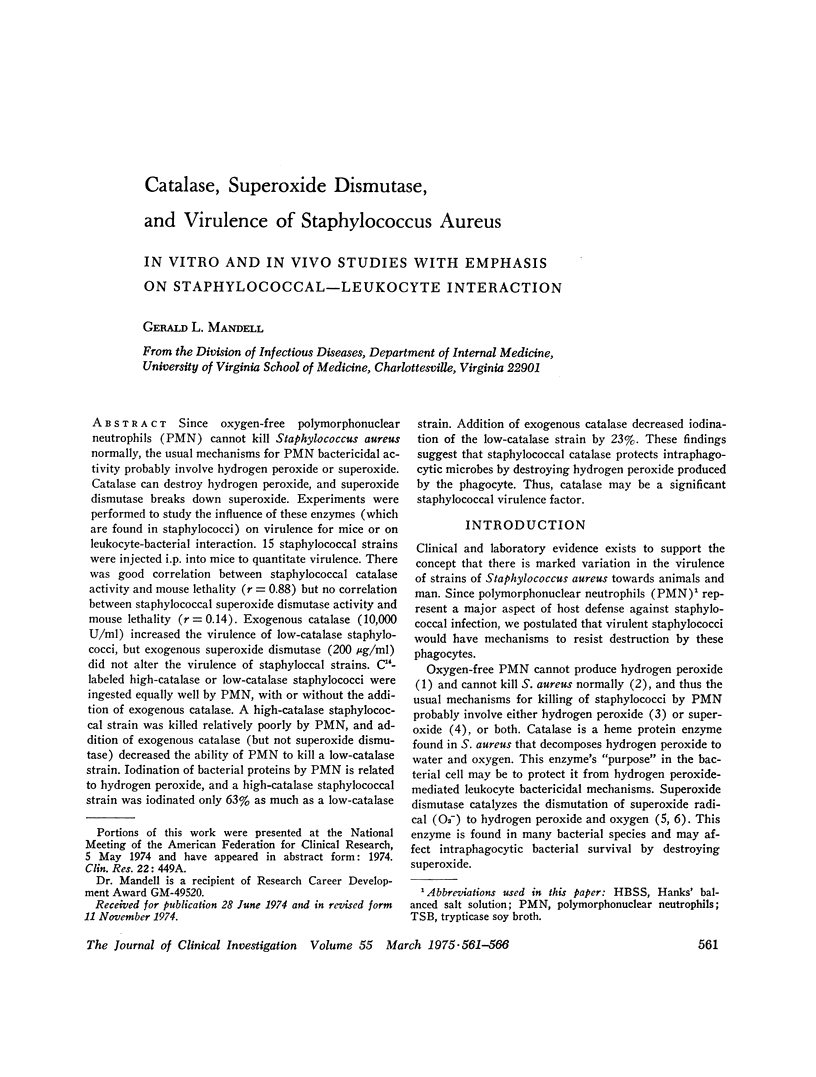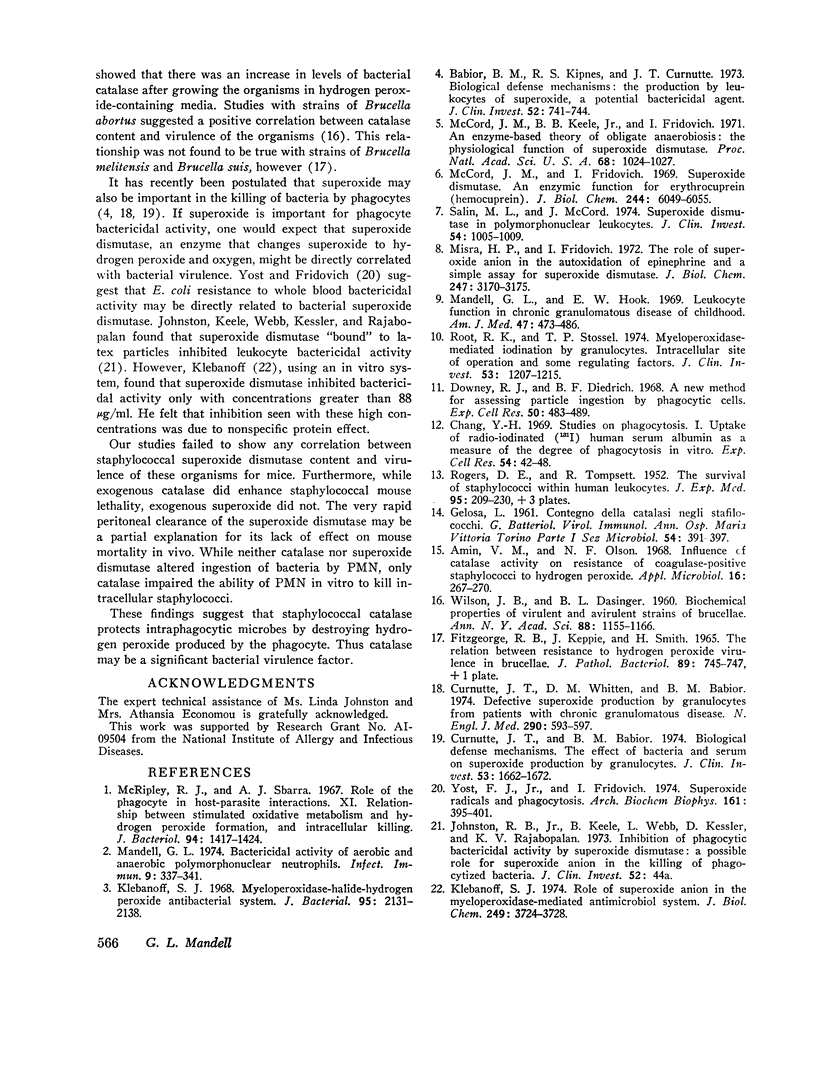Abstract
Since oxygen-free polymorphonuclear neutrophils (PMN) cannot kill Staphylococcus aureus normally, the usual mechanisms for PMN bactericidal activity probably involve hydrogen peroxide or superoxide. Catalase can destroy hydrogen peroxide, and superoxide dismutase breaks down superoxide. Experiments were performed to study the influence of these enzymes (which are found in staphylococci) on virulence for mice or on leukocyte-bacterial interaction. 15 staphylococcal strains were injected i.p. into mice to quantitate virulence. There was good correlation between staphylococcal catalase activity and mouse lethality (r equals 0.88) but no correlation between staphylococcal superoxide dismutase activity and mouse lethality (r equals 0.14). Exogenous catalase (10,000 U/ml) increased the virulence of low-catalase staphylococci, but exogenous superoxide dismutase (200 mug/ml) did not alter the virulence of staphyloccal strains. C14=labeled high-catalase or low-catalase staphylococci were ingested equally well by PMN, with or without the addition of exogenous catalase. A high-catalase staphylococcal strain was killed relatively poorly by PMN, and addition of exogenous catalase (but not superoxide dismutase) decreased the ability of PMN to kill a low-catalase strain. Iodination of bacterial proteins by PMN is related to hydrogen peroxide, and a high-catalase staphylococcal strain was iodinated only 63% as much as a low-catalase strain. Addition of exogenous catalase decreased iodination of the low-catalase strain by 23%. These findings suggest that staphylococcal catalase protects intraphagocytic microbes by destroying hydrogen peroxide produced by the phagocyte. Thus, catalase may be a significant staphylococcal virulence factor.
Full text
PDF





Selected References
These references are in PubMed. This may not be the complete list of references from this article.
- Amin V. M., Olson N. F. Influence of catalase activity on resistance of coagulase-positive staphylococci to hydrogen peroxide. Appl Microbiol. 1968 Feb;16(2):267–270. doi: 10.1128/am.16.2.267-270.1968. [DOI] [PMC free article] [PubMed] [Google Scholar]
- Babior B. M., Kipnes R. S., Curnutte J. T. Biological defense mechanisms. The production by leukocytes of superoxide, a potential bactericidal agent. J Clin Invest. 1973 Mar;52(3):741–744. doi: 10.1172/JCI107236. [DOI] [PMC free article] [PubMed] [Google Scholar]
- Chang Y. H. Studies on phagocytosis. I. Uptake of radio-iodinated (131-I) human serum albumin as a measure of the degree of phagocytosis in vitro. Exp Cell Res. 1969 Jan;54(1):42–48. doi: 10.1016/0014-4827(69)90290-0. [DOI] [PubMed] [Google Scholar]
- Curnutte J. T., Babior B. M. Biological defense mechanisms. The effect of bacteria and serum on superoxide production by granulocytes. J Clin Invest. 1974 Jun;53(6):1662–1672. doi: 10.1172/JCI107717. [DOI] [PMC free article] [PubMed] [Google Scholar]
- Curnutte J. T., Whitten D. M., Babior B. M. Defective superoxide production by granulocytes from patients with chronic granulomatous disease. N Engl J Med. 1974 Mar 14;290(11):593–597. doi: 10.1056/NEJM197403142901104. [DOI] [PubMed] [Google Scholar]
- Downey R. J., Diedrich B. F. A new method for assessing particle ingestion by phagocytic cells. Exp Cell Res. 1968 Jun;50(3):483–489. doi: 10.1016/0014-4827(68)90411-4. [DOI] [PubMed] [Google Scholar]
- FITZGEORGE R. B., KEPPIE J., SMITH H. THE RELATION BETWEEN RESISTANCE TO HYDROGEN PEROXIDE AND VIRULENCE IN BRUCELLAE. J Pathol Bacteriol. 1965 Apr;89:745–747. doi: 10.1002/path.1700890239. [DOI] [PubMed] [Google Scholar]
- Klebanoff S. J. Myeloperoxidase-halide-hydrogen peroxide antibacterial system. J Bacteriol. 1968 Jun;95(6):2131–2138. doi: 10.1128/jb.95.6.2131-2138.1968. [DOI] [PMC free article] [PubMed] [Google Scholar]
- Klebanoff S. J. Role of the superoxide anion in the myeloperoxidase-mediated antimicrobial system. J Biol Chem. 1974 Jun 25;249(12):3724–3728. [PubMed] [Google Scholar]
- Mandell G. L. Bactericidal activity of aerobic and anaerobic polymorphonuclear neutrophils. Infect Immun. 1974 Feb;9(2):337–341. doi: 10.1128/iai.9.2.337-341.1974. [DOI] [PMC free article] [PubMed] [Google Scholar]
- Mandell G. L., Hook E. W. Leukocyte function in chronic granulomatous disease of childhood. Studies on a seventeen year old boy. Am J Med. 1969 Sep;47(3):473–486. doi: 10.1016/0002-9343(69)90231-9. [DOI] [PubMed] [Google Scholar]
- McCord J. M., Fridovich I. Superoxide dismutase. An enzymic function for erythrocuprein (hemocuprein). J Biol Chem. 1969 Nov 25;244(22):6049–6055. [PubMed] [Google Scholar]
- McCord J. M., Keele B. B., Jr, Fridovich I. An enzyme-based theory of obligate anaerobiosis: the physiological function of superoxide dismutase. Proc Natl Acad Sci U S A. 1971 May;68(5):1024–1027. doi: 10.1073/pnas.68.5.1024. [DOI] [PMC free article] [PubMed] [Google Scholar]
- McRipley R. J., Sbarra A. J. Role of the phagocyte in host-parasite interactions. XI. Relationship between stimulated oxidative metabolism and hydrogen peroxide formation, and intracellular killing. J Bacteriol. 1967 Nov;94(5):1417–1424. doi: 10.1128/jb.94.5.1417-1424.1967. [DOI] [PMC free article] [PubMed] [Google Scholar]
- Misra H. P., Fridovich I. The role of superoxide anion in the autoxidation of epinephrine and a simple assay for superoxide dismutase. J Biol Chem. 1972 May 25;247(10):3170–3175. [PubMed] [Google Scholar]
- ROGERS D. E., TOMPSETT R. The survival of staphylococci within human leukocytes. J Exp Med. 1952 Feb;95(2):209–230. doi: 10.1084/jem.95.2.209. [DOI] [PMC free article] [PubMed] [Google Scholar]
- Root R. K., Stossel T. P. Myeloperoxidase-mediated iodination by granulocytes. Intracellular site of operation and some regulating factors. J Clin Invest. 1974 May;53(5):1207–1215. doi: 10.1172/JCI107667. [DOI] [PMC free article] [PubMed] [Google Scholar]
- Salin M. L., McCord J. M. Superoxide dismutases in polymorphonuclear leukocytes. J Clin Invest. 1974 Oct;54(4):1005–1009. doi: 10.1172/JCI107816. [DOI] [PMC free article] [PubMed] [Google Scholar]
- WILSON J. B., DASINGER B. L. Biochemical properties of virulent and avirulent strains of brucellae. Ann N Y Acad Sci. 1960 Nov 21;88:1155–1166. doi: 10.1111/j.1749-6632.1960.tb20106.x. [DOI] [PubMed] [Google Scholar]
- Yost F. J., Jr, Fridovich I. Superoxide radicals and phagocytosis. Arch Biochem Biophys. 1974 Apr 2;161(2):395–401. doi: 10.1016/0003-9861(74)90320-8. [DOI] [PubMed] [Google Scholar]


